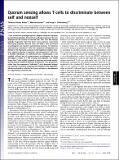| dc.contributor.author | Butler, Thomas Charles | |
| dc.contributor.author | Kardar, Mehran | |
| dc.contributor.author | Chakraborty, Arup K | |
| dc.date.accessioned | 2014-03-24T16:02:57Z | |
| dc.date.available | 2014-03-24T16:02:57Z | |
| dc.date.issued | 2013-07 | |
| dc.date.submitted | 2012-12 | |
| dc.identifier.issn | 0027-8424 | |
| dc.identifier.issn | 1091-6490 | |
| dc.identifier.uri | http://hdl.handle.net/1721.1/85904 | |
| dc.description.abstract | T cells orchestrate pathogen-specific adaptive immune responses by identifying peptides derived from pathogenic proteins that are displayed on the surface of infected cells. Host cells also display peptide fragments from the host’s own proteins. Incorrectly identifying peptides derived from the body’s own proteome as pathogenic can result in autoimmune disease. To minimize autoreactivity, immature T cells that respond to self-peptides are deleted in the thymus by a process called negative selection. However, negative selection is imperfect, and autoreactive T cells exist in healthy individuals. To understand how autoimmunity is yet avoided, without loss of responsiveness to pathogens, we have developed a model of T-cell training and response. Our model shows that T cells reliably respond to infection and avoid autoimmunity because collective decisions made by the T-cell population, rather than the responses of individual T cells, determine biological outcomes. The theory is qualitatively consistent with experimental data and yields a criterion for thymic selection to be adequate for suppressing autoimmunity. | en_US |
| dc.description.sponsorship | National Institutes of Health (U.S.). Pioneer Award | en_US |
| dc.description.sponsorship | National Science Foundation (U.S.) (Grant 12-06323) | en_US |
| dc.language.iso | en_US | |
| dc.publisher | National Academy of Sciences (U.S.) | en_US |
| dc.relation.isversionof | http://dx.doi.org/10.1073/pnas.1222467110 | en_US |
| dc.rights | Article is made available in accordance with the publisher's policy and may be subject to US copyright law. Please refer to the publisher's site for terms of use. | en_US |
| dc.source | PNAS | en_US |
| dc.title | Quorum sensing allows T cells to discriminate between self and nonself | en_US |
| dc.type | Article | en_US |
| dc.identifier.citation | Butler, T. C., M. Kardar, and A. K. Chakraborty. “Quorum Sensing Allows T Cells to Discriminate Between Self and Nonself.” Proceedings of the National Academy of Sciences 110, no. 29 (July 16, 2013): 11833–11838. | en_US |
| dc.contributor.department | Massachusetts Institute of Technology. Institute for Medical Engineering & Science | en_US |
| dc.contributor.department | Massachusetts Institute of Technology. Department of Biological Engineering | en_US |
| dc.contributor.department | Massachusetts Institute of Technology. Department of Chemical Engineering | en_US |
| dc.contributor.department | Massachusetts Institute of Technology. Department of Chemistry | en_US |
| dc.contributor.department | Massachusetts Institute of Technology. Department of Physics | en_US |
| dc.contributor.department | Ragon Institute of MGH, MIT and Harvard | en_US |
| dc.contributor.mitauthor | Butler, Thomas Charles | en_US |
| dc.contributor.mitauthor | Kardar, Mehran | en_US |
| dc.contributor.mitauthor | Chakraborty, Arup K. | en_US |
| dc.relation.journal | Proceedings of the National Academy of Sciences | en_US |
| dc.eprint.version | Final published version | en_US |
| dc.type.uri | http://purl.org/eprint/type/JournalArticle | en_US |
| eprint.status | http://purl.org/eprint/status/PeerReviewed | en_US |
| dspace.orderedauthors | Butler, T. C.; Kardar, M.; Chakraborty, A. K. | en_US |
| dc.identifier.orcid | https://orcid.org/0000-0003-1268-9602 | |
| dc.identifier.orcid | https://orcid.org/0000-0002-1112-5912 | |
| mit.license | PUBLISHER_POLICY | en_US |
| mit.metadata.status | Complete | |

